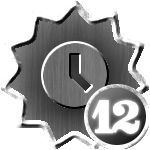-
Posts
146 -
Joined
-
Last visited
About jacob

Contact Methods
-
ICQ
0
-
Website URL
http://
-
AIM
doctah barton
Profile Information
-
Interests
invented instruments, microtonal (xenharmonic) music, scale creation (emphasis on linear tunings), highbrow academic squeak-fart music, conceptualism, rhythmic virtuosity, electronic (concrete) music, music with a social agenda, absolute music, music of alien cultures, linguistics, (psycho)acoustics, stereometry, clean music, dirty music.
jacob's Achievements
-
yo, i'd say you're barking up the right tree if you get a DAW you like. "metro" is what i've used to make tons of microtonal mockups. My friend Dan uses Logic, which works if you are using 12 or less tones per octave. i run midi sequences out of metro, to Scala, which retunes the midi (using all 16 channels) of whatever synthesizer (soft or hard). the annoying thing is trying to work with mulitple timbres - usually i record the audio from one timbre & then add on top of it. Li'l Miss Scale Oven (nonoctave.com - Tuning Software for the Mac) is a (non-free) alternative to Scala that works with more synthesizers & has all sorts of neat features - tuning to multiple scales at once, for example. An alternative to live-retuning midi signals is having a synthesizer that lets you set it to alternative tunings, e.g. the Emu Proteus I have. None of these options give you a microtonal piano roll. Blue, a Csound environment, has a microtonal piano roll that I've never gotten to work. I've gotten pretty good at just using my ear and learning "scordatura" perspectives on normal keyboards (e.g. if the keyboard is tuned to 31-equal, the octave looks like 2 octaves + a fifth). Hope this helps : )
-
Hello, I was bit by the microtonal bug five years ago. When one is a musician and also in the habit of questioning the assumptions provided to you by your inherited culture, a rigorous questioning of "How and Why do we tune the way we do?" along with "What if it were different?" yields a rich hidden valley of music & idea. Some thoughts I have: 1. There are myriad tunings, each one different. And I mean perceptibly different, if you took the time to compare them side by side. And why wouldn't you, you careful craftsperson and artist, take the proper time to choose your tools? Each one is capable of doing different things, much like different languages are. I recommend reading the writings of undersung microtonal pioneer Ivor Darreg. But: 2. Tunings have no inherent sound of their own because what we hear is always what we think to play in them! Many a broad dismissal have been made by people who never heard tunings, or heard them used in particularly unflattering ways. I hear talk of 19-equal and wonder if anyone took the time to try 17-equal? (Having been part of piano concerts in both tunings, I decide I like both tunings, though on pianos they are perhaps not at their best.) 3. Seek an alternative to a hierarchical view of tunings. Please. Don't make 12 tone equal temperament (the Western status quo for the past 100 years only) THE standard against which to measure every other scale, and take care that you don't overthrow it and simply place the Harmonic Series in its throne. Ivor Darreg said "There are no bad scales." 4. Synthesizers are easy to retune. Scala is an excellent piece of free software, and there are plenty of other programs and softsynths to satisfy. 5. Acoustic instruments are not so easy! Some you have to modify extensively or redesign completely (seen the double-barrel quarter-tone clarinet?) and the ones you don't require new techniques which require patience and dedication to learn how to hear differently. Toward that end, I'm holding a Thirty-one-tone singing camp in NYC in two weeks. Figuring out what's possible is a collaborative project I'm interested in and have barely started. 6. Hundreds of people have experimented with microtonality, some of them with results they aren't too embarrassed about to share. This list can give you a taste, but as always, so much more is possible! (Microtonality is not a style.)
-
scant little progress on project udderbot, for all those on edge of chair: www.udderbot.com exists, though it's very mere at the moment. soon to exist is a Composer's Guide to the Udderbot, replete with a Catalogue of Special Affects. I first imagined a series of podcasts but now am convinced that something like youtube would be much more effective. stay tuned.
-
Skip the minute or so of introduction (Portuguese!) http://www.podcast1.com.br/canais/canal107/attica_programa.mp3 score is here: Werner Icking Music Archive: Frederic Rzewski Performance varies; I myself would prefer the voice part less piercing. I recommend it with the following smiley: ;)
-
In reading the words of Kyle Gann I have latched onto two principles that came in tandem with minimalism and whose implications are bigger than the original movement. 1: "It's only as good as it sounds." The surface texture of music is an important thing for a composer to consider. 2, and this one hails from Cage somewhere or another: Taking the behemoth attention paid to harmony in the last centuries and turning it towards rhythm. Rhythm as aspect of primary interest. Hmmm. The possibility of being accused of laziness is a troubling issue that I must give more thought...
-

When You Hear "experimental music" what do you think of?
jacob replied to Luluberyllium's topic in Composers' Headquarters
Experiment can be a part of musicmaking at any or all stages of musicmaking. One can make an experiment of composition, or even before composition (that is, make an experiment and take it as input to composition). One could make a piece with the intent of making an experiment out of the listening (that is, noticing the novelty of matching this music with these ears). Experimental music is not always scientific-method music, with a hypothesis and all that, though it can be. A favorite quote of mine, albeit a complaint, from Mark Enslin/Herbert Brun: "The multimodal monoculture neither converses nor discusses; it chats, gossips, hangs out, flips through, watches. (Experiment is disparaged, experimenters ostracized,...) The banishment of play from work forces play to be a relief from work; this makes difficulty not an attraction but at best a sales pitch inflating the value of one's work in order to impress higher-ups. Cultural obliteracy from the spontaneity factory." -
too much rubato! also on youtube is a performance by greg anderson...me like...even if the video is way more produced that classical is used to... this semester i decided i wanted to learn etude IV: fanfares. i didn't practice enough (yet), can almost get through it at about 2/3-tempo. fanfares was my favorite for a while, but in obsessing over it i've overdosed on the saccharine harmonies (ha!)
-
15/16. 15/16 is similar to 7/8 in its "minus-one" relationship to 4/4, but 15/16 goes further, depriving you by a mere sixteenth-note of your expectation. That's only one grouping, of course (4 4 4 3). There are others, (5 5 5) and (5 4 3 2 1) being my favorites. I wrote a snippet in 15/16 for an amazing string quartet and they couldn't really sightread it. (It wasn't fast or anything.) Three years ago I wrote another snippet that was a variation on Mozart, as part of a project here. You can listen over here.
-
oog, stupid freeservers. here, then. uws.mid
-
Hello folks, http://hebdomekontany.freeservers.com/uws.mid I improvised this back in the 20th century (1999 is my guess), in two parts, with the help of a sequencer's input effects. Namely, an arpeggio function and a repeat-chord function. Like any improvisation, the recording is a mere shadow of the original experience; and yet I listen again and again for those brief flashes of "how the heck did I do that?" I'm thinking of arranging this for piano, harpsichord and percussion for an upcoming call for scores. Don't hold me to it though. Enjoy, I suppose.
-
How about a thread where you have to make progress on a composition as a pre-requisite to posting? Not in a forced way - you don't have to prove that you did something. But perhaps you report what it is you did. As a way to encourage the blooming of both creativity and discussions.
-
Ligeti died last month. Rats. I wanted to meet him. This reminded me of this paper I just read by Heinz von Foerster: http://grace.evergreen.edu/~arunc/texts/cy...nz/disorder.pdf We the observer create the order, stop hiding behind illusions of objectivity, etc. etc. My favorite of Ligeti's remains his piano etudes, and the other stuff on the Mechanical Music album, especially Hungarian Rock.
-
I don't have much of a soul, and I'm a little crazy these days, but you don't have to rub it in. What is profundity and how does it differ from pointlessness?
-
How are the prime numbers translated into music? There are many ways to do this which I have thought of, but this isn't one of them.
-
today i suspected of making references in my music to bartok's second string quartet, and possibly mahler's 1st symphony. but i'm innocent. and they're subtle.



